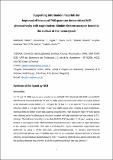Files in this item
Improved efficiency of PbS quantum dot sensitized NiO photocathodes with naphthalene diimide electron acceptor bound to the surface of the nanocrystals
Item metadata
| dc.contributor.author | Raissi, Mahfoudh | |
| dc.contributor.author | Sajjad, Muhammad T. | |
| dc.contributor.author | Farré, Yoann | |
| dc.contributor.author | Roland, Thomas J. | |
| dc.contributor.author | Ruseckas, Arvydas | |
| dc.contributor.author | Samuel, Ifor D. W. | |
| dc.contributor.author | Odobel, Fabrice | |
| dc.date.accessioned | 2019-01-11T00:33:44Z | |
| dc.date.available | 2019-01-11T00:33:44Z | |
| dc.date.issued | 2018-07 | |
| dc.identifier | 251867785 | |
| dc.identifier | 48d9c5a6-85e2-4367-a604-62dcccdfafbc | |
| dc.identifier | 85040374777 | |
| dc.identifier | 000433269900011 | |
| dc.identifier.citation | Raissi , M , Sajjad , M T , Farré , Y , Roland , T J , Ruseckas , A , Samuel , I D W & Odobel , F 2018 , ' Improved efficiency of PbS quantum dot sensitized NiO photocathodes with naphthalene diimide electron acceptor bound to the surface of the nanocrystals ' , Solar Energy Materials and Solar Cells , vol. 181 , pp. 71-76 . https://doi.org/10.1016/j.solmat.2017.12.029 | en |
| dc.identifier.issn | 0927-0248 | |
| dc.identifier.other | ORCID: /0000-0001-9114-3522/work/40797745 | |
| dc.identifier.uri | https://hdl.handle.net/10023/16844 | |
| dc.description | Funding: European Research Council (grant number 321305) and the EPSRC (grant number EP/L017008/1). IDWS is a Royal Society Wolfson Research Merit award holder. | en |
| dc.description.abstract | Hybrid materials combining a wide bandgap metal oxide semiconductor, metal chalcogenide nanocrystals and molecular systems represent very attractive materials for fabricating devices with new function or improved photoelectrochemical performances. This study deals with sensitization of NiO, which is a p-type semiconductor, by quantum dots (QDs) of PbS with an average diameter of 3 nm. The PbS QDs were attached to the monocrystalline film of NiO by mercaptopropionic acid linker and were subsequently capped with methyl-pyridine naphthalene diimide (NDI) units to prepare quantum dot sensitized solar cells (p-QDSSCs) on NiO electrodes. Time-resolved photoluminescence measurements of the PbS emission were used to determine the rate constants for charge transfer from the PbS exciton to the NiO, cobalt based redox mediator and NDI. Notably, it was shown that NDI quenches the PbS exciton by electron transfer with a quite fast rate constant (6.9 x 107 s-1). The PbS QDs sensitized NiO films were finally used to fabricate solar cells with tris(4,4’-ditert-butyl-2,2’-bipyridine) cobalt(III/II) as redox mediator. It was observed that the presence of NDI on PbS improved the photovoltaic performance by 50% relative to that of cells without NDI, leading to a device with the following characteristics: Jsc = 5.75 mA/cm2, Voc = 226 mV, ff = 34% and PCE = 0.44%. This study demonstrates that photogalvanic processes can be a productive pathway to better performing sensitized p-type semiconductor for p-QDSSC. In other words, photoinduced electron transfer from the QDs towards the electrolyte rather than initial photoinduced charge injection into the p-type semiconductor can be a favorable operative mechanism in QD sensitized NiO films and might be exploited further for the construction of better performing solar cells or photocatalytic devices. | |
| dc.format.extent | 6 | |
| dc.format.extent | 713897 | |
| dc.format.extent | 453629 | |
| dc.language.iso | eng | |
| dc.relation.ispartof | Solar Energy Materials and Solar Cells | en |
| dc.subject | Photocathode | en |
| dc.subject | Quantum dot sensitized solar cell | en |
| dc.subject | Time resolved emission | en |
| dc.subject | Lead sulfide | en |
| dc.subject | Photoinduced hole transfer | en |
| dc.subject | QC Physics | en |
| dc.subject | TK Electrical engineering. Electronics Nuclear engineering | en |
| dc.subject | DAS | en |
| dc.subject | SDG 7 - Affordable and Clean Energy | en |
| dc.subject.lcc | QC | en |
| dc.subject.lcc | TK | en |
| dc.title | Improved efficiency of PbS quantum dot sensitized NiO photocathodes with naphthalene diimide electron acceptor bound to the surface of the nanocrystals | en |
| dc.type | Journal article | en |
| dc.contributor.sponsor | EPSRC | en |
| dc.contributor.sponsor | European Research Council | en |
| dc.contributor.sponsor | EPSRC | en |
| dc.contributor.institution | University of St Andrews. School of Physics and Astronomy | en |
| dc.contributor.institution | University of St Andrews. Condensed Matter Physics | en |
| dc.identifier.doi | 10.1016/j.solmat.2017.12.029 | |
| dc.description.status | Peer reviewed | en |
| dc.date.embargoedUntil | 2019-01-11 | |
| dc.identifier.grantnumber | EP/K039210/1 | en |
| dc.identifier.grantnumber | en | |
| dc.identifier.grantnumber | ep/l017008/1 | en |
This item appears in the following Collection(s)
Items in the St Andrews Research Repository are protected by copyright, with all rights reserved, unless otherwise indicated.


